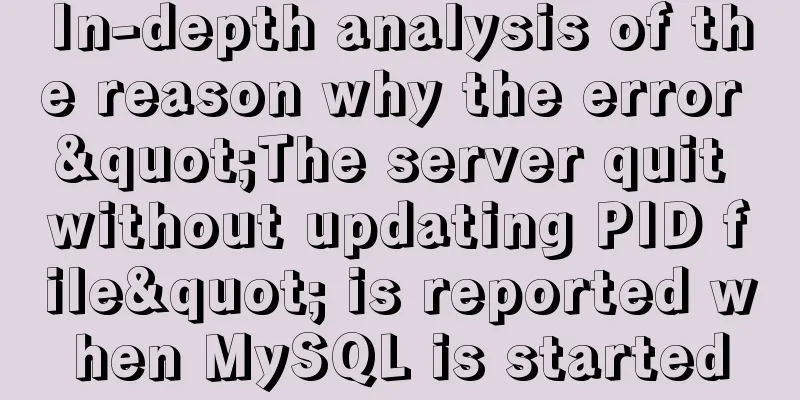In-depth analysis of the reason why the error "The server quit without updating PID file" is reported when MySQL is started

|
Many people have encountered this error when starting MySQL. First of all, let me clarify that the premise for this error is to start mysql through the service script. Starting the MySQL instance through mysqld_safe or mysqld will not report this error. So, what is the specific reason for this error? Haha, if you don’t care about the analysis process, you can jump directly to the summary at the end of the article~ Summarize Next, let's analyze the mysql service startup script The complete script is as follows:
#!/bin/sh
# Copyright Abandoned 1996 TCX DataKonsult AB & Monty Program KB & Detron HB
# This file is public domain and comes with NO WARRANTY of any kind
# MySQL daemon start/stop script.
# Usually this is put in /etc/init.d (at least on machines SYSV R4 based
# systems) and linked to /etc/rc3.d/S99mysql and /etc/rc0.d/K01mysql.
# When this is done the mysql server will be started when the machine is
# started and shut down when the systems goes down.
# Comments to support chkconfig on RedHat Linux
# chkconfig: 2345 64 36
# description: A very fast and reliable SQL database engine.
# Comments to support LSB init script conventions
### BEGIN INIT INFO
# Provides: mysql
# Required-Start: $local_fs $network $remote_fs
# Should-Start: ypbind nscd ldap ntpd xntpd
# Required-Stop: $local_fs $network $remote_fs
# Default-Start: 2 3 4 5
# Default-Stop: 0 1 6
# Short-Description: start and stop MySQL
# Description: MySQL is a very fast and reliable SQL database engine.
### END INIT INFO
# If you install MySQL on some other places than /usr/local/mysql, then you
# have to do one of the following things for this script to work:
#
# - Run this script from within the MySQL installation directory
# - Create a /etc/my.cnf file with the following information:
# [mysqld]
# basedir=<path-to-mysql-installation-directory>
# - Add the above to any other configuration file (for example ~/.my.ini)
# and copy my_print_defaults to /usr/bin
# - Add the path to the mysql-installation-directory to the basedir variable
# below.
#
# If you want to affect other MySQL variables, you should make your changes
# in the /etc/my.cnf, ~/.my.cnf or other MySQL configuration files.
# If you change base dir, you must also change datadir. These may get
# overwritten by settings in the MySQL configuration files.
basedir=
datadir=
# Default value, in seconds, after which the script should timeout waiting
# for server start.
# Value here is overriden by value in my.cnf.
# 0 means don't wait at all
# Negative numbers mean to wait indefinitely
service_startup_timeout=900
# Lock directory for RedHat / SuSE.
lockdir='/var/lock/subsys'
lock_file_path="$lockdir/mysql"
# The following variables are only set for letting mysql.server find things.
# Set some defaults
mysqld_pid_file_path=
if test -z "$basedir"
then
basedir=/usr/local/mysql
bindir=/usr/local/mysql/bin
if test -z "$datadir"
then
datadir=/usr/local/mysql/data
fi
sbindir=/usr/local/mysql/bin
libexecdir=/usr/local/mysql/bin
else
bindir="$basedir/bin"
if test -z "$datadir"
then
datadir="$basedir/data"
fi
sbindir="$basedir/sbin"
libexecdir="$basedir/libexec"
fi
# datadir_set is used to determine if datadir was set (and so should be
# *not* set inside of the --basedir= handler.)
datadir_set=
#
# Use LSB init script functions for printing messages, if possible
#
lsb_functions="/lib/lsb/init-functions"
if test -f $lsb_functions ; then
. $lsb_functions
else
log_success_msg()
{
echo " SUCCESS! $@"
}
log_failure_msg()
{
echo " ERROR! $@"
}
fi
PATH="/sbin:/usr/sbin:/bin:/usr/bin:$basedir/bin"
export PATH
mode=$1 # start or stop
[ $# -ge 1 ] && shift
other_args="$*" # uncommon, but needed when called from an RPM upgrade action
# Expected: "--skip-networking --skip-grant-tables"
# They are not checked here, intentionally, as it is the resposibility
# of the "spec" file author to give correct arguments only.
case `echo "testing\c"`,`echo -n testing` in
*c*,-n*) echo_n= echo_c= ;;
*c*,*) echo_n=-n echo_c= ;;
*) echo_n= echo_c='\c' ;;
esac
parse_server_arguments() {
for arg do
case "$arg" in
--basedir=*) basedir=`echo "$arg" | sed -e 's/^[^=]*=//'`
bindir="$basedir/bin"
if test -z "$datadir_set"; then
datadir="$basedir/data"
fi
sbindir="$basedir/sbin"
libexecdir="$basedir/libexec"
;;
--datadir=*) datadir=`echo "$arg" | sed -e 's/^[^=]*=//'`
datadir_set=1
;;
--pid-file=*) mysqld_pid_file_path=`echo "$arg" | sed -e 's/^[^=]*=//'` ;;
--service-startup-timeout=*) service_startup_timeout=`echo "$arg" | sed -e 's/^[^=]*=//'` ;;
esac
done
}
wait_for_pid () {
verb="$1" # created | removed
pid="$2" # process ID of the program operating on the pid-file
pid_file_path="$3" # path to the PID file.
i=0
avoid_race_condition="by checking again"
while test $i -ne $service_startup_timeout ; do
case "$verb" in
'created')
# wait for a PID-file to pop into existence.
test -s "$pid_file_path" && i='' && break
;;
'removed')
# wait for this PID-file to disappear
test ! -s "$pid_file_path" && i='' && break
;;
*)
echo "wait_for_pid () usage: wait_for_pid created|removed pid pid_file_path"
exit 1
;;
esac
# if server isn't running, then pid-file will never be updated
if test -n "$pid"; then
if kill -0 "$pid" 2>/dev/null; then
: # the server still runs
else
# The server may have exited between the last pid-file check and now.
if test -n "$avoid_race_condition"; then
avoid_race_condition=""
continue # Check again.
fi
# there's nothing that will affect the file.
log_failure_msg "The server quit without updating PID file ($pid_file_path)."
return 1 # not waiting any more.
fi
fi
echo $echo_n ".$echo_c"
i=`expr $i + 1`
sleep 1
done
if test -z "$i" ; then
log_success_msg
return 0
else
log_failure_msg
return 1
fi
}
# Get arguments from the my.cnf file,
# the only group, which is read from now on is [mysqld]
if test -x ./bin/my_print_defaults
then
print_defaults="./bin/my_print_defaults"
elif test -x $bindir/my_print_defaults
then
print_defaults="$bindir/my_print_defaults"
elif test -x $bindir/mysql_print_defaults
then
print_defaults="$bindir/mysql_print_defaults"
else
# Try to find basedir in /etc/my.cnf
conf=/etc/my.cnf
print_defaults=
if test -r $conf
then
subpat='^[^=]*basedir[^=]*=\(.*\)$'
dirs=`sed -e "/$subpat/!d" -e 's//\1/' $conf`
for d in $dirs
do
d=`echo $d | sed -e 's/[ ]//g'`
if test -x "$d/bin/my_print_defaults"
then
print_defaults="$d/bin/my_print_defaults"
break
fi
if test -x "$d/bin/mysql_print_defaults"
then
print_defaults="$d/bin/mysql_print_defaults"
break
fi
done
fi
# Hope it's in the PATH ... but I doubt it
test -z "$print_defaults" && print_defaults="my_print_defaults"
fi
#
# Read defaults file from 'basedir'. If there is no defaults file there
# check if it's in the old (depricated) place (datadir) and read it from there
#
extra_args=""
if test -r "$basedir/my.cnf"
then
extra_args="-e $basedir/my.cnf"
else
if test -r "$datadir/my.cnf"
then
extra_args="-e $datadir/my.cnf"
fi
fi
parse_server_arguments `$print_defaults $extra_args mysqld server mysql_server mysql.server`
#
# Set pid file if not given
#
if test -z "$mysqld_pid_file_path"
then
mysqld_pid_file_path=$datadir/`hostname`.pid
else
case "$mysqld_pid_file_path" in
/* ) ;;
* )mysqld_pid_file_path="$datadir/$mysqld_pid_file_path" ;;
esac
fi
case "$mode" in
'start')
# Start daemon
# Safeguard (relative paths, core dumps..)
cd $basedir
echo $echo_n "Starting MySQL"
if test -x $bindir/mysqld_safe
then
# Give extra arguments to mysqld with the my.cnf file. This script
# may be overwritten at next upgrade.
$bindir/mysqld_safe --datadir="$datadir" --pid-file="$mysqld_pid_file_path" $other_args >/dev/null 2>&1 &
wait_for_pid created "$!" "$mysqld_pid_file_path"; return_value=$?
# Make lock for RedHat / SuSE
if test -w "$lockdir"
then
touch "$lock_file_path"
fi
exit $return_value
else
log_failure_msg "Couldn't find MySQL server ($bindir/mysqld_safe)"
fi
;;
'stop')
# Stop daemon. We use a signal here to avoid having to know the
# root password.
if test -s "$mysqld_pid_file_path"
then
mysqld_pid=`cat "$mysqld_pid_file_path"`
if (kill -0 $mysqld_pid 2>/dev/null)
then
echo $echo_n "Shutting down MySQL"
kill $mysqld_pid
# mysqld should remove the pid file when it exits, so wait for it.
wait_for_pid removed "$mysqld_pid" "$mysqld_pid_file_path"; return_value=$?
else
log_failure_msg "MySQL server process #$mysqld_pid is not running!"
rm "$mysqld_pid_file_path"
fi
# Delete lock for RedHat / SuSE
if test -f "$lock_file_path"
then
rm -f "$lock_file_path"
fi
exit $return_value
else
log_failure_msg "MySQL server PID file could not be found!"
fi
;;
'restart')
# Stop the service and regardless of whether it was
# running or not, start it again.
if $0 stop $other_args; then
$0 start $other_args
else
log_failure_msg "Failed to stop running server, so refusing to try to start."
exit 1
fi
;;
'reload'|'force-reload')
if test -s "$mysqld_pid_file_path" ; then
read mysqld_pid < "$mysqld_pid_file_path"
kill -HUP $mysqld_pid && log_success_msg "Reloading service MySQL"
touch "$mysqld_pid_file_path"
else
log_failure_msg "MySQL PID file could not be found!"
exit 1
fi
;;
'status')
# First, check to see if pid file exists
if test -s "$mysqld_pid_file_path" ; then
read mysqld_pid < "$mysqld_pid_file_path"
if kill -0 $mysqld_pid 2>/dev/null ; then
log_success_msg "MySQL running ($mysqld_pid)"
exit 0
else
log_failure_msg "MySQL is not running, but PID file exists"
exit 1
fi
else
# Try to find appropriate mysqld process
mysqld_pid=`pidof $libexecdir/mysqld`
# test if multiple pids exist
pid_count=`echo $mysqld_pid | wc -w`
if test $pid_count -gt 1 ; then
log_failure_msg "Multiple MySQL running but PID file could not be found ($mysqld_pid)"
exit 5
elif test -z $mysqld_pid ; then
if test -f "$lock_file_path" ; then
log_failure_msg "MySQL is not running, but lock file ($lock_file_path) exists"
exit 2
fi
log_failure_msg "MySQL is not running"
exit 3
else
log_failure_msg "MySQL is running but PID file could not be found"
exit 4
fi
fi
;;
*)
# usage
basename=`basename "$0"`
echo "Usage: $basename {start|stop|restart|reload|force-reload|status} [ MySQL server options ]"
exit 1
;;
esac
exit 0First, define the relevant parameters basedir= datadir= # Default value, in seconds, after which the script should timeout waiting # for server start. # Value here is overriden by value in my.cnf. # 0 means don't wait at all # Negative numbers mean to wait indefinitely service_startup_timeout=900 # Lock directory for RedHat / SuSE. lockdir='/var/lock/subsys' lock_file_path="$lockdir/mysql" in, basedir refers to the directory where the binary compressed package is unpacked, for example /usr/local/mysql. datadir refers to the data directory service_startup_timeout=900 defines the time limit for starting the MySQL service. If the service fails to start within 900 seconds, the script will exit. lockdir='/var/lock/subsys' Regarding /var/lock/subsys, the explanation on the Internet is as follows, which will be used later. In general, the system shutdown process (issuing a shutdown signal and calling the service's own process) will check the files under /var/lock/subsys and shut down each service one by one. If a running service does not have a corresponding option under /var/lock/subsys. When the system is shut down, this service will be killed like a normal process. By looking at the scripts under /etc/rc.d/init.d, you can find that each service will check the corresponding service under /var/lock/subsys when operating itself. Many programs need to determine whether there is already an instance running. This directory is a sign for the program to determine whether there is an instance running. For example, if this file exists, it means that xinetd is already running, otherwise it is not. Of course, there must be corresponding judgment measures in the program to truly determine whether there is an instance running. Usually, this directory is accompanied by a /var/run directory, which is used to store the PID of the corresponding instance. If you write scripts, you will find that these two directories combined can easily determine whether many services are running, related information about the running, etc. Determine basedir and datadir # Set some defaults mysqld_pid_file_path= if test -z "$basedir" then basedir=/usr/local/mysql bindir=/usr/local/mysql/bin if test -z "$datadir" then datadir=/usr/local/mysql/data fi sbindir=/usr/local/mysql/bin libexecdir=/usr/local/mysql/bin else bindir="$basedir/bin" if test -z "$datadir" then datadir="$basedir/data" fi sbindir="$basedir/sbin" libexecdir="$basedir/libexec" fi in, mysqld_pid_file_path specifies the path to the pid file -z string determines whether the string is empty If basedir is not explicitly set, the default is /usr/local/mysql. This is why many MySQL installation tutorials recommend placing MySQL-related files in /usr/local/mysql. If datadir is not explicitly set, it defaults to $basedir/data. Define log_success_msg() and log_failure_msg() functions First, determine whether the /lib/lsb/init-functions file exists. If it does, make all shell functions defined in the init-functions file effective in the current script. If not, define two functions, one for printing success logs and the other for printing error logs. In RHCS 6.7, this file does not exist and has been replaced by /etc/init.d/functions.
#
# Use LSB init script functions for printing messages, if possible
#
lsb_functions="/lib/lsb/init-functions"
if test -f $lsb_functions ; then
. $lsb_functions
else
log_success_msg()
{
echo " SUCCESS! $@"
}
log_failure_msg()
{
echo " ERROR! $@"
}
fiPassing Parameters Pass the first argument to mode and the remaining arguments to other_args PATH="/sbin:/usr/sbin:/bin:/usr/bin:$basedir/bin" export PATH mode=$1 # start or stop [ $# -ge 1 ] && shift other_args="$*" # uncommon, but needed when called from an RPM upgrade action # Expected: "--skip-networking --skip-grant-tables" # They are not checked here, intentionally, as it is the resposibility # of the "spec" file author to give correct arguments only. case `echo "testing\c"`,`echo -n testing` in *c*,-n*) echo_n= echo_c= ;; *c*,*) echo_n=-n echo_c= ;; *) echo_n= echo_c='\c' ;; esac Parsing parameters in configuration files This function will be referred to later in the script. The main parameters involved are: --basedir, --datadir, --pid-file, --service-startup-timeout.
parse_server_arguments() {
for arg do
case "$arg" in
--basedir=*) basedir=`echo "$arg" | sed -e 's/^[^=]*=//'`
bindir="$basedir/bin"
if test -z "$datadir_set"; then
datadir="$basedir/data"
fi
sbindir="$basedir/sbin"
libexecdir="$basedir/libexec"
;;
--datadir=*) datadir=`echo "$arg" | sed -e 's/^[^=]*=//'`
datadir_set=1
;;
--pid-file=*) mysqld_pid_file_path=`echo "$arg" | sed -e 's/^[^=]*=//'` ;;
--service-startup-timeout=*) service_startup_timeout=`echo "$arg" | sed -e 's/^[^=]*=//'` ;;
esac
done
}Determine the location of my_print_defaults First, it checks whether the executable file exists in the bin directory under the current path. If not, it checks whether it exists in the $bindir (usually $basedir/bin) directory. If it still does not exist, it will determine whether /etc/my.cnf exists and is readable. If so, it will determine whether the basedir parameter is specified in the configuration file. If specified, take the value of the parameter and determine whether there is a bin/my_print_defaults executable file in the directory corresponding to the value. The last step, if the my_print_defaults file is not found in the above directory, Simply set print_defaults to "my_print_defaults" and hope that the command is in the current PATH environment. # Get arguments from the my.cnf file, # the only group, which is read from now on is [mysqld] if test -x ./bin/my_print_defaults then print_defaults="./bin/my_print_defaults" elif test -x $bindir/my_print_defaults then print_defaults="$bindir/my_print_defaults" elif test -x $bindir/mysql_print_defaults then print_defaults="$bindir/mysql_print_defaults" else # Try to find basedir in /etc/my.cnf conf=/etc/my.cnf print_defaults= if test -r $conf then subpat='^[^=]*basedir[^=]*=\(.*\)$' dirs=`sed -e "/$subpat/!d" -e 's//\1/' $conf` for d in $dirs do d=`echo $d | sed -e 's/[ ]//g'` if test -x "$d/bin/my_print_defaults" then print_defaults="$d/bin/my_print_defaults" break fi if test -x "$d/bin/mysql_print_defaults" then print_defaults="$d/bin/mysql_print_defaults" break fi done fi # Hope it's in the PATH ... but I doubt it test -z "$print_defaults" && print_defaults="my_print_defaults" fi Find the default configuration file -r file True if the file is readable # # Read defaults file from 'basedir'. If there is no defaults file there # check if it's in the old (depricated) place (datadir) and read it from there # extra_args="" if test -r "$basedir/my.cnf" then extra_args="-e $basedir/my.cnf" else if test -r "$datadir/my.cnf" then extra_args="-e $datadir/my.cnf" fi fi Parsing parameters in configuration files The usage of my_print_defaults is as follows: my_print_defaults --defaults-file=example.cnf client mysql That is, read the parameter configuration of the client and mysql parts in the configuration file. Specifically, in this script, the configuration parameters of mysqld, server, mysql_server, and mysql.server are read. parse_server_arguments `$print_defaults $extra_args mysqld server mysql_server mysql.server` Set the path to the pid file -z string determines whether the string is empty If --pid-file is not set in the configuration file read or the mysqld_pid_file_path parameter is not set at the beginning of the script, The pid file is set under datadir by default and is named hostname.pid. If this parameter is set, further judgment is required If this parameter contains a slash, it means that the given value has a path and can be used directly. If there is no path in this parameter, it means that the given value is just the file name of the pid, which can be set under datadir. # # Set pid file if not given # if test -z "$mysqld_pid_file_path" then mysqld_pid_file_path=$datadir/`hostname`.pid else case "$mysqld_pid_file_path" in /* ) ;; * )mysqld_pid_file_path="$datadir/$mysqld_pid_file_path" ;; esac fi Service script start options First, switch to $basedir Secondly, determine whether mysqld_safe in $basedir/bin is an executable file. If it is, start the mysqld instance. If not, report an error and exit. So, how is the startup process implemented? First, execute the $bindir/mysqld_safe --datadir="$datadir" --pid-file="$mysqld_pid_file_path" $other_args >/dev/null 2>&1 & command to start the mysqld instance. Did you notice that mysqld_safe is actually executed in basedir, including the mysql initialization script mysql_install_db, which is also recommended to be executed in basedir. For details, please refer to: Analyzing the MariaDB initialization script mysql_install_db Then the wait_for_pid function is used for judgment. For details, see the analysis of the wait_for_pid function below. After the judgment is completed, Check whether the $lockdir directory is writable. If it is writable, create a file in the directory. case "$mode" in 'start') # Start daemon # Safeguard (relative paths, core dumps..) cd $basedir echo $echo_n "Starting MySQL" if test -x $bindir/mysqld_safe then # Give extra arguments to mysqld with the my.cnf file. This script # may be overwritten at next upgrade. $bindir/mysqld_safe --datadir="$datadir" --pid-file="$mysqld_pid_file_path" $other_args >/dev/null 2>&1 & wait_for_pid created "$!" "$mysqld_pid_file_path"; return_value=$? # Make lock for RedHat / SuSE if test -w "$lockdir" then touch "$lock_file_path" fi exit $return_value else log_failure_msg "Couldn't find MySQL server ($bindir/mysqld_safe)" fi ;; wait_for_pid function After starting the MySQL instance using mysqld_safe, this parameter will be called wait_for_pid created "$!" "$mysqld_pid_file_path"; return_value=$? $! is used in the shell to get the PID of the last running background process. In this case, it is the PID of the mysqld_safe process. Because the first parameter is created, -s file True if file has non-zero length This command means that if the pid file exists, the variable i is set to empty and the while loop is exited. Then perform the following judgment: if test -z "$i" ; then log_success_msg return 0 else log_failure_msg return 1 fi If $i is empty, the success log is printed and the script exits. Obviously, if the pid file exists, the variable i will be set to empty. Let's take a look at the situation where the pid file does not exist First, it checks whether $pid is not empty (i.e. if test -n "$pid") If it is not empty, it means that the pid of the process has been captured after executing mysqld_safe. In this case, further confirm whether the process exists by using kill -0 "$pid". kill -0 does not send any signal, but the system will perform an error check, so it is often used to check whether a process exists. When the process does not exist, kill -0 pid will return an error. If the process exists, no operation is performed and the following operation is directly skipped. echo $echo_n ".$echo_c" i=`expr $i + 1` sleep 1 Increment the variable i by 1 and sleep for 1 second. Then, continue the while loop. The reason for doing this is that mysqld_safe has been executed, but the mysqld instance is still in the startup process and the pid file has not been created yet. Until $1 reaches the duration defined by $service_startup_timeout. If during the while loop, you determine that the process no longer exists by using kill -0 "$pid", It will judge again. If the result of this judgment is still that the pid file does not exist and the process does not exist, it will execute log_failure_msg "The server quit without updating PID file ($pid_file_path)." This is the origin of the famous "The server quit without updating PID file".
wait_for_pid () {
verb="$1" # created | removed
pid="$2" # process ID of the program operating on the pid-file
pid_file_path="$3" # path to the PID file.
i=0
avoid_race_condition="by checking again"
while test $i -ne $service_startup_timeout ; do
case "$verb" in
'created')
# wait for a PID-file to pop into existence.
test -s "$pid_file_path" && i='' && break
;;
'removed')
# wait for this PID-file to disappear
test ! -s "$pid_file_path" && i='' && break
;;
*)
echo "wait_for_pid () usage: wait_for_pid created|removed pid pid_file_path"
exit 1
;;
esac
# if server isn't running, then pid-file will never be updated
if test -n "$pid"; then
if kill -0 "$pid" 2>/dev/null; then
: # the server still runs
else
# The server may have exited between the last pid-file check and now.
if test -n "$avoid_race_condition"; then
avoid_race_condition=""
continue # Check again.
fi
# there's nothing that will affect the file.
log_failure_msg "The server quit without updating PID file ($pid_file_path)."
return 1 # not waiting any more.
fi
fi
echo $echo_n ".$echo_c"
i=`expr $i + 1`
sleep 1
done
if test -z "$i" ; then
log_success_msg
return 0
else
log_failure_msg
return 1
fi
}Service script stop option First, determine whether the length of the pid file is not zero. -s file True if file has non-zero length At this point, the pid of the mysqld process will be obtained through the pid file. Note that it is not the pid of the mysqld_safe process. Then, determine whether the mysqld process is running normally. If yes, shut down the mysqld process by killing $mysqld_pid The safest way to kill a process is to simply use the kill command, with no modifiers or flags. The standard kill command usually terminates the problematic process and releases the process's resources to the system. However, if the process started child processes, only killing the parent process will keep the child processes running and therefore still consume resources. To prevent these so-called "zombie processes", make sure to kill all of its child processes before killing the parent process. Then, the wait_for_pid function is called to make a judgment. In fact, the purpose of setting the avoid_race_condition variable in the wait_for_pid function is for the stop option. It is indeed possible that mysqld exits after checking the pid file and before checking whether the process is alive. If the mysqld process is not running properly, the message "MySQL server process #$mysqld_pid is not running!" will be printed and the pid file will be deleted. If the length of the pid file is 0 when stop is executed, the message "MySQL server PID file could not be found!" is printed. Therefore, if the pid file does not exist, executing the stop option through the service script will not shut down the mysqld process. At this time, you can shut down the mysqld process by killing $mysqld_pid. 'stop') # Stop daemon. We use a signal here to avoid having to know the # root password. if test -s "$mysqld_pid_file_path" then mysqld_pid=`cat "$mysqld_pid_file_path"` if (kill -0 $mysqld_pid 2>/dev/null) then echo $echo_n "Shutting down MySQL" kill $mysqld_pid # mysqld should remove the pid file when it exits, so wait for it. wait_for_pid removed "$mysqld_pid" "$mysqld_pid_file_path"; return_value=$? else log_failure_msg "MySQL server process #$mysqld_pid is not running!" rm "$mysqld_pid_file_path" fi # Delete lock for RedHat / SuSE if test -f "$lock_file_path" then rm -f "$lock_file_path" fi exit $return_value else log_failure_msg "MySQL server PID file could not be found!" fi ;; Service script restart option First, execute the stop operation. If the stop operation is successful, continue to execute the start operation. If the stop operation fails, the message "Failed to stop running server, so refusing to try to start." will be output and the script will exit. 'restart') # Stop the service and regardless of whether it was # running or not, start it again. if $0 stop $other_args; then $0 start $other_args else log_failure_msg "Failed to stop running server, so refusing to try to start." exit 1 fi ;; Service script reload options First, determine whether the length of the pid file is 0. If not, set the value in the file to the value of the mysqld_pid variable. Then execute the kill -HUP operation on the process. kill -HUP pid pid is the process ID. Use this command if you want to change the configuration without stopping and restarting the service. After making the necessary changes to the configuration files, issue this command to dynamically update the service configuration. By convention, when you send a hangup signal (signal 1 or HUP), most server processes (all normal processes) reset and reload their configuration files. If the length of the pid file is 0, "MySQL PID file could not be found!" is output. 'reload'|'force-reload') if test -s "$mysqld_pid_file_path" ; then read mysqld_pid < "$mysqld_pid_file_path" kill -HUP $mysqld_pid && log_success_msg "Reloading service MySQL" touch "$mysqld_pid_file_path" else log_failure_msg "MySQL PID file could not be found!" exit 1 fi ;; Service script status option First, determine whether the length of the pid file is 0. If not, read the value in the file and determine whether the process corresponding to the pid is running normally. If it runs normally, it will output "MySQL running" If it is not normal, the output is "MySQL is not running, but PID file exists" If the length of the pid file is 0, try to get its pid through the mysqld startup command. At this time, there may be a mysqld program that starts multiple instances, which will cause pid_count=`echo $mysqld_pid | wc -w` to be greater than 1. At this time, the message "Multiple MySQL running but PID file could not be found" will be output and the script will exit. If mysqld_pid is empty, it will continue to check whether "$lock_file_path" exists. If it exists, The message "MySQL is not running, but lock file ($lock_file_path) exists" is output. If "$lock_file_path" does not exist, the message "MySQL is not running" will be output. If mysqld_pid is equal to 1, the message "MySQL is running but PID file could not be found" is output. 'status') # First, check to see if pid file exists if test -s "$mysqld_pid_file_path" ; then read mysqld_pid < "$mysqld_pid_file_path" if kill -0 $mysqld_pid 2>/dev/null ; then log_success_msg "MySQL running ($mysqld_pid)" exit 0 else log_failure_msg "MySQL is not running, but PID file exists" exit 1 fi else # Try to find appropriate mysqld process mysqld_pid=`pidof $libexecdir/mysqld` # test if multiple pids exist pid_count=`echo $mysqld_pid | wc -w` if test $pid_count -gt 1 ; then log_failure_msg "Multiple MySQL running but PID file could not be found ($mysqld_pid)" exit 5 elif test -z $mysqld_pid ; then if test -f "$lock_file_path" ; then log_failure_msg "MySQL is not running, but lock file ($lock_file_path) exists" exit 2 fi log_failure_msg "MySQL is not running" exit 3 else log_failure_msg "MySQL is running but PID file could not be found" exit 4 fi fi ;; Service script other options If the first argument of the script is not one of the above options, Usage information will be output.
*)
# usage
basename=`basename "$0"`
echo "Usage: $basename {start|stop|restart|reload|force-reload|status} [ MySQL server options ]"
exit 1
;;At this point, the analysis of the mysql service script is complete~ Summarize When starting MySQL through the service script, the error "The server quit without updating PID file" is reported. There are two conditions First, the pid file does not exist Secondly, check that the process does not exist by killing -0 $pid At this time, the error can only be located through the error log of the MySQL database. If the service script is not adjusted, the default basedir is /usr/local/mysql and datadir is /usr/local/mysql/data If your MySQL service is not in the default path, You need to explicitly set it in the script After testing, the following settings are required: 1. Set basedir and add conf variables Here, conf refers to the configuration file of mysqld. It is recommended to explicitly specify the values of basedir and datadir in the configuration file. Here, datadir does not need to be set because datadir can be obtained through the configuration file. But basedir must be specified, because the my_print_deefauts command must first be judged according to basedir basedir=/usr/local/mysql-advanced-5.6.23-linux-glibc2.5-x86_64 datadir= conf=/usr/local/mysql-advanced-5.6.23-linux-glibc2.5-x86_64/my_3308.cnf 2. Line 256, add extra_args=" -c $conf" extra_args=" -e $basedir/my.cnf.bak" if test -r "$basedir/my.cnf" then extra_args="-e $basedir/my.cnf" else if test -r "$datadir/my.cnf" then extra_args="-e $datadir/my.cnf" fi fi extra_args=" -c $conf" 3. Modify the startup parameters of mysqld_safe in line 285 Will $bindir/mysqld_safe --datadir="$datadir" --pid-file="$mysqld_pid_file_path" $other_args >/dev/null 2>&1 & Modified to, $bindir/mysqld_safe --defaults-file="$conf" --datadir="$datadir" --pid-file="$mysqld_pid_file_path" $other_args >/dev/null 2>&1 & Mainly added the --defaults-file option The above is an in-depth analysis of the reasons why the error "The server quit without updating PID file" appears when MySQL is started. I hope it will be helpful to you. If you have any questions, please leave me a message and I will reply to you in time. I would also like to thank everyone for their support of the 123WORDPRESS.COM website! You may also be interested in:
|
<<: How to use less in WeChat applet (optimal method)
>>: How to set up FTP server in CentOS7
Recommend
How to build a private Docker repository using Harbor
Table of contents 1. Open source warehouse manage...
Detailed tutorial for installing winx64 under mysql8.0.18 (with pictures and text)
Go to https://dev.mysql.com/downloads/mysql/ to d...
Linux Jenkins configuration salve node implementation process diagram
Preface: Jenkins' Master-Slave distributed ar...
Vue sample code for easily implementing virtual scrolling
Table of contents Preface Rolling principle accom...
Correct use of MySQL partition tables
Overview of MySQL Partitioned Tables We often enc...
CSS to achieve Skeleton Screen effect
When loading network data, in order to improve th...
Tutorial diagram of installing CentOS and Qt in Vmware virtual machine
Vmware Installation Installing Packages Download ...
Detailed explanation of how to manually deploy a remote MySQL database in Linux
1. Install mysql Run the following command to upd...
MySQL 8.0.15 installation and configuration graphic tutorial under Win10
This article records the installation and configu...
Solution to the problem that the entry cannot be found when installing mysql5.7.18
The following problem occurred when installing my...
MySQL green decompression version installation and configuration steps
Steps: 1. Install MySQL database 1. Download the ...
Double loading issue when the page contains img src
<br />When the page contains <img src=&qu...
A brief discussion on VUE uni-app conditional coding and page layout
Table of contents Conditional compilation Page La...
Use the docker build kit to build a Docker image that can be used on the Raspberry Pi
Docker Installation curl -fsSL https://get.docker...
Detailed steps for porting busybox to build a minimal root file system
Busybox: A Swiss Army knife filled with small com...









